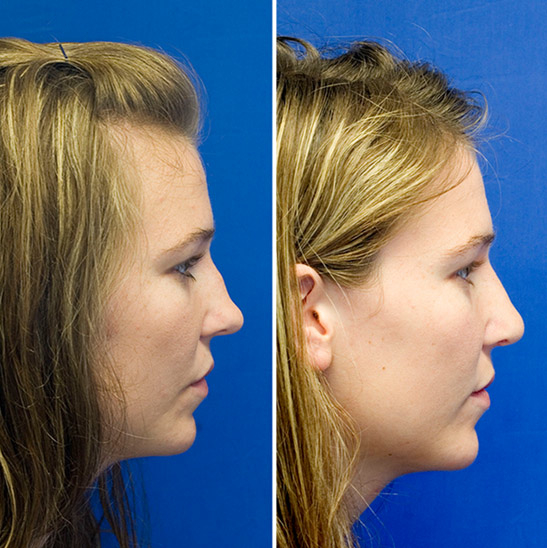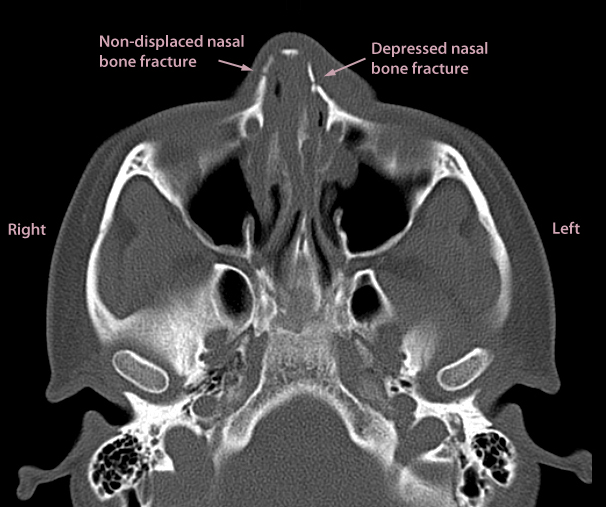Broken Nose Repair
What to do if you think you have a broken nose
Many of us sustain relatively minor  to our nose without suffering any major problems. If you are concerned that you may have done more damage to your nose with a recent injury what should you do?
to our nose without suffering any major problems. If you are concerned that you may have done more damage to your nose with a recent injury what should you do?
Right after the initial trauma you may want to gently place an ice pack on your nose to help with the soreness and to minimize skin swelling. It is common to also have a bloody nose, though this isn't indicative of whether you have actually broken your nose or not. Often the bleeding stops on its own after a couple minutes. A couple sprays of over the counter decongestant nasal spray (such as Afrin) can also help slow down persistent nose bleeding.
Get your nose examined
The first step in having your nose evaluated is to see a provider experienced in evaluating this type of facial trauma. Seeing your primary care provider (or an urgent care clinic/emergency department) is a great first step. If there is concern for a nasal fracture they will then refer you to an otolaryngologist (ear, nose, throat doctor) or facial plastic surgeon as those specialties have extensive training in evaluating and treating facial and nasal injuries. Of course, if your insurance allows you may set up an appointment directly with an otolaryngologist or facial plastic surgeon.
Signs and symptoms of a broken nose
In some situations it may be quite obvious that you have broken your nose. This is likely the case if your nose is drastically more deviated than it used to be. This assessment can be complicated by the fact that asymmetric skin swelling can make the nose look more deviated than it actually is.
Importantly, the presence of bruising is not a sure sign that you have a broken nose.
A careful examination of the nose can often reveal whether there are more subtle signs of nasal bone fracture, including being able to feel a bony "step off" along a fracture line.
It turns out that besides breaking the nasal bones you can also injure the cartilage of the nose with trauma. This can involve cracking or shifting the septum (dividing wall inside the nose) or disrupting the normal attachment of outer nasal cartilage (upper lateral cartilage) to the nasal bone.
This patient suffered an injury to the lower aspect of the bridge of her nose that resulted in a saddle nose deformity. This occurred when the trauma cracked the septal support in that portion of her bridge. After waiting for the swelling to dissipate, Dr. Lamperti repaired the injury using rhinoplasty surgery:

Check for septal hematoma
Another part of the initial examination is to check the inside of the nose to look for signs of injury to the nasal septum. In the acute setting a septal hematoma must be ruled out. A septal hematoma is a collection of blood under the skin lining of the septum. This collection may occur during acute trauma if a septal blood vessel is injured. It is important to drain this hematoma as it can become infected and destroy the septal cartilage leading to a permanent saddle nose deformity.
Can a nasal fracture cause a septal deviation?
It is possible to develop a deviated nasal septum after breaking your nose. A sign that this may have occurred includes significantly restricted airflow on one or both sides of the nose.
It is common for the nose to become somewhat stuffy after any injury (related to swelling of the internal skin lining) so you do need a thorough nasal exam to fully assess whether you have signs of a deviated septum. Depending on the severity of the deviation and your symptoms you may want to have the deviated septum treated at the same time as your nasal fracture.
Do you need a nasal x-ray or CT scan to evaluate a broken nose?
In some cases your provider may want to get an x-ray or CT scan of your facial region to further assess for a nasal fracture. It is important to understand that radiological imaging is not required in the evaluation of all nasal trauma. Depending on the type of injury a CT may be indicated to rule out other facial fractures that may be hard to diagnosed with a physical exam alone.
The CT scan below shows the nose of a patient who suffered a nasal fracture just a few hours before:

Note how the right nasal bone has a non-displaced fracture and the left nasal bone is fractured in a depressed position. You can also see how the overlying skin on the left side (the gray overlying the white bone) of the nose appears thicker due to temporary tissue swelling from the injury.
Do you have to fix all broken noses?
Once your facial plastic surgeon or otolaryngologist has decided that you do have a nasal fracture the next step is to assess whether the nasal bones are displaced, or out of alignment. It is possible to fracture the nasal bones but have them maintain their normal position. In this situation you may simply leave the nose alone and allow the bones to heal on their own. Your doctor may want to place an external cast on your nose to help protect the bones as they reset.
How long can you wait to reset a broken nose?
If the bones are shifted or displaced the typical treatment is to have a closed nasal fracture reduction. Once the nasal bones are fractured you have a few weeks to fix the injury. The bone edges gradually heal together over the course of about 6 weeks. The initial bony union is fibrous and then progressively hardens over time. It is best to reset a broken nose within the first two weeks or so after the initial injury. Dr. Lamperti has successfully reset fractured noses after this time frame, but the delay can make the procedure more challenging.
How to fix a broken nose using a closed nasal fracture reduction
As previously mentioned, a closed nasal fracture reduction is the typical treatment for a broken nose. The "closed" terminology refers to the fact that no incisions are being used to reposition the broken nasal bones. The precise method of reducing the out of place nasal bones varies among different surgeons. The main goal is to manually mobilize the broken nasal bone(s) and reposition them back in the proper position. The general process involves using a blunt surgical instrument which is placed inside the nose and allows the surgeon to push the fractured nasal bone into proper alignment.
This video below shows how closed nasal fracture reduction is done and what the nasal cast looks like after the procedure.
You can see that broken nose repair takes just a few minutes to complete. It can be done in the operating room under anesthesia (like in the video above) such that you don't feel the procedure at all. It is also possible to perform in an office setting using a combination of topical numbing medication (that is placed inside the nose on cotton pledgets) and an injection of numbing medication.
The cast that is placed at the end of the procedure is typically left on for about one week. Its role is mainly to act as a protective helmet and prevent repositioning of the reset nasal bone into the wrong location.
Deviated nose repair
So what happens if you wait too long before seeing a doctor and the nasal bones have already fully reset into a crooked position? Luckily it is still possible to treat this nasal deviation using more complex rhinoplasty techniques. Learn more about crooked nose treatment here.

Meet Plastic Surgeon, Dr. Lamperti
Dr. Lamperti, a Seattle rhinoplasty super-specialist, has devoted his career to treatments of the head, face and neck. He feels that by focusing his plastic surgery endeavors solely to the face he is best able to provide the excellent results his patients desire.
Interested in learning more about having a Rhinoplasty Treatment in Seattle with Dr. Lamperti?
Contact us to have a private consultation or view Before & After photos here.